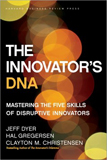|
The Innovator’s DNA / Dyer,
Gregerson & Christensen / Harvard Business Review Press
A guest column, written by our
colleague, Bob Donnelly from New Jersey, USA. Bob is the editor of the
Entrepreneurial CEO column at Chief Executive Magazine, and an educator, author,
and coach. Author of GUIDEBOOK TO PLANNING - A Common Sense Approach, available
on Amazon, and now as an audio book.
[email protected]
________________________________
Getting Practical About Practicing Innovation
A Book Review by Bob Donnelly, CEO of VAAS Americas
Originally published on
Chief Executive.Net on the 9th of August 2011
There are almost as many books about business innovation as there are biographies of Lincoln or Jesus. Most are mediocre and forgettable. A few actually are helpful. The Innovator’s DNA may be one of the latter. It’s written by three well-known and widely published academics from Brigham Young University, INSEAD, and Harvard, who seek in practical terms to explain the managerial ingredients required to generate and execute a continuum of innovative business ideas. The authors have identified five skills of disruptive innovators supported by interviews and analysis from the innovative leaders at Amazon, Apple, Google, Skype, the Virgin Group, and others.
The author’s take the reader through what they call the DNA of Disruptive Innovators explaining the discovery skills of: Associating, Questioning, Observing, Networking, and Experimenting. The book begins with a motivational message, “Disruptive innovation starts with you!” And an inspirational quote from the innovator’s innovator, Steve Jobs, “I want to put a ding in the universe.”
The authors describe the discovery skills as follows:
Associating. Innovators think differently by connecting the unconnected. The authors spent time with Jobs during their research and quote him often. For example, “when you ask creative people how they did something, they feel a little guilty because they didn’t really do it, they just saw something.” This statement led the authors to conclude that innovative leaders associate what they observe and cross-pollinate ideas in their own heads and in others. They have determined from their research that innovative ideas flourish at the intersection of diverse experiences, whether it be those of the innovators, or others.
The authors also provide sections in the book to be filled in by the reader to help force new associations and challenge the reader to provide “what-ifs” to generate some possible new features and benefits.
Discovering. Questioning is another key element of the author’s research results, and they cite a statement from Ratan Tata — “question the unquestionable.” They conclude that questioning is a way of life for innovators. Former Procter & Gamble CEO A.G. Lafley changed the game at P&G by asking lots of questions. Like, who is your target customer here? What does she want? What do you know about her? What kind of an experience does she really want? What does she think she is missing today?
The authors also conclude that innovators ask disruptive questions and constantly challenge common wisdom. Innovators treat the world as a question mark. With the classic question being — “why has no one else ever thought of this before?” For good measure the authors offer a disruptive innovator’s questionnaire in the book for reader’s to complete and motivate them to think of their own ideas.
Observing. The authors conclude that most innovators are intense observers. As a great example, they discuss an experience that Ratan Tata had on a rainy day in Mumbai that inspired him to create the world’s cheapest car. Tata noticed a lower-middle-class man riding a scooter with his wife and children precariously balanced on different angles on the scooter, and all of them soaked to the bone. At that moment he asked himself, “why can’t this family own a car and avoid the rain?” Of course such observations are common to anyone traveling in India. The difference is that he was compelled to take the next step, something that isn’t commonplace.
The result is the Tata Nano priced at $2,200. The car can be assembled from kits at dealerships. It was India’s car of the year in 2010. This innovation went on to bundle financing, insurance, registration, and even driving lessons for new customers who had never owned a car as part of the total Nano car ownership experience.
Steve Jobs observed that consumers needed the Apple Store where they could browse, examine, and learn about all of Apple’s neat new devices, and even ask questions at a genius bar. And Howard Schultz did the same thing while wandering around Italy and stopping in at Italian espresso bars, which was the genesis of Starbuck’s.
The authors also provide Ten Questions to Ask While Observing Customers, another wonderful and useful tool in the book.
Discovering. Another part of The Innovator’s DNA is that thinking outside of the box often requires linking ideas with others who may not be in your immediate sphere of reference. This networking process is another characteristic of innovators. The authors describe this as bridging gaps in social networks to get new ideas much like we are seeing frequently now with one new emerging social network after another. For example, a tweet can lead to another tweet that eventually results in a new product or service.
They even recommend forming a personal networking group of “go-to” folks to work with to find or test new ideas. The authors found that many innovators have a small group of creative confidants that they can bounce their ideas for new concepts off of. Michael Dell described it as a collaborative approach building on each member by asking, “how about this, or how about that.”
The authors also offer a variety of what they call “tips” in the book for developing idea network skills, as well as an outline on how to diversify your idea network.
Experimenting. Here the authors cite Thomas Edison, “I haven’t failed… I just found 10,000 ways that did not work.” Jeff Bezos started Amazon by asking, “what would people buy remotely?” That led to his launching Amazon as the Earth’s Biggest Bookstore.
When Bezos was a child, and fed up with sleeping in his crib, he tried to take it apart with a screwdriver. This experimentation lasted through his teen years with an unending series of other experiments.
The authors outline three ways to experiment:
1.try out new experiences
2.take apart products, processes and ideas
3.test ideas through pilots and prototypes.
Their research also revealed that one of the most powerful experiments innovators can try is living and working in different cultures. Of those who have lived and worked abroad, 35 percent are more likely to start an innovative venture or invent a new product. They cite P&G’s A.G. Laffley’s and Howard Schultz’s international experiences, among others.
The DNA of innovative organizations typically reflects the founder’s attitudes and beliefs, but over time it also is a reflection of the people, the philosophies, and internal processes of the enterprise. Such firms believe that:
1.innovation is part of everyone’s job
2.disruptive innovation is part of their innovation portfolio
3.there are lots of small properly organized innovation project teams
4.smart risks should be taken in the pursuit of innovation
The fastest way for an organization to die is to stop innovating, and we certainly have seen many examples of that fact recently. The current dilemma at Nokia is a direct result of Apple’s innovation with the iPhone while innovation languished at Nokia, the pioneer in cellular phone technology.
In summary, the most innovative companies in the world have leaders who understand innovation at a deeply personal level. They lead the innovative charge with a high discovery quotient and regularly contribute innovative ideas to the company. The epitome of such a leader is Steve Jobs. The results of the research done on the world’s most innovative companies by Christensen, Dyer, and Gregersen reveals that the DNA of innovative organizations mirrors the DNA of innovative individuals. Jeff Bezos captured this quite eloquently — “Innovation is deeply ingrained in all of the nooks and cranies of our culture.”
|



